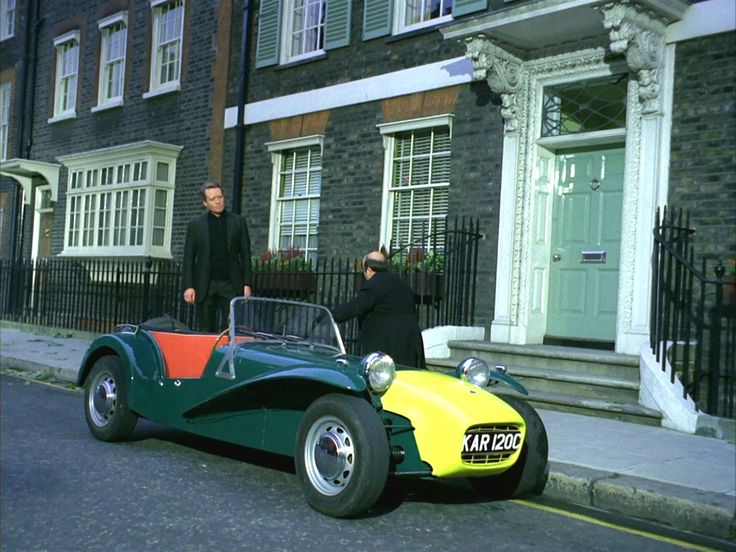The Prisoner was first transmitted in the UK on 29th September 1967 and in honour of its 50th birthday, I decided to re-watch the entire series. The accumulative effect of viewing all the 17 episodes (albeit not in the same evening) is of renewed amazement at the scope and power of the show, of how Leo McKern will always remain one of my favourite actors – and of the variety of cars. A. B. and C features a Citroen DS19, the comedy of The Girl Who Was Death guest-starred a Jaguar E-Type 3.8 Roadster and Fall Out (officially one of the greatest 50 minutes of British television of all time) had a cameo from a Bentley S-Type that was the property of one Patrick McGoohan. But asides from the Princess 4-Litre Hearse of the opening credits, the vehicles that will forever be associated with The Prisoner are the Lotus Super Seven and the Mini Moke.
When The Prisoner was being planned, one of the issues to be considered was the star’s main on-screen transport. A Mini Cooper would have been out of the question as McGoohan had already driven a Taurus-tuned Austin 1071S in the 1964-1966 series of Danger Man. A Bristol or an Aston Martin DB6 was too close to the then popular image of a ‘soigné ‘international man of mystery’ while an MG, Sunbeam or Triumph did not quite suit an actor of such a non-conformist image.

However, in 1966 McGoohan paid a visit to the Lotus plant where, in the words of The Prisoner Handbook, he rejected the opportunity to use an Elan ‘after falling in love with Seven’. The actor wanted a car for ‘the “individual’ and there was also the issue that in the mid-1960s the Elan was already associated with Emma Peel in The Avengers. Episode No. 7, Many Happy Returns, has No. 6 declaring that ‘I know every nut and bolt. I built it with my bare hands’. Such is the intensity of Patrick McGoohan’s performance that one entirely believes him.
The first 12 editions of The Prisoner commenced with McGoohan driving the Lotus and KAR 120 was a Lotus Super Seven Series II demonstrator that was powered by a Cosworth-tuned 1.5-litre engine. The first scene of the opening credits was shot in August 1966 at Poddington Raceway in Northampton. We then see No. 6 driven over Westminster Bridge and as he is too unorthodox a chap to have ordered his Seven with flashing indicators he makes right-turn hand signal into Abington Street Car Park. His mews home is No.1 Buckingham Place, where he is followed by a sinister-looking hearse…
By August 1967 the Lotus was required for some scenes of the 13th story. As the original S2 demonstrator had been sold to a customer in Australia another car, registration LCK 88D was hired from a Borehamwood motorist named Frank Rycroft for Do Not Forsake Me Oh My Darling. By that time McGoohan was otherwise engaged on the film Ice Station Zebra and so the plot of the 13th Prisoner revolved around No. 6 having his mind transferred into another body; shots of the distinguished character actor Nigel Stock were combined with stock footage. In addition, a 100E-powered Standard Seven – note the front brake drums and the slightly different number plate mounted over the grille – had to be rapidly modified or its crucial role in the last reel of Fall Out.
The other car that automatically conjures memories of Fenella Fielding announcing, ‘Rise and shine!’ is, of course, the Mini Moke. When location filming at Portmeirion began in September 1966 the light utility that BMC had originally intended as military transport had already undergone a considerable change of image. This was now a ‘fun car’, as demonstrated by its appearance in the underrated 1965 pop film/British road movie Catch Us If You Can and the Moke was ideal for the brightly coloured, ever-so-jolly and very frightening Village. The Prisoner often gives the impression of No.2 and his minions having a vast fleet of cars at their disposal but only four Wood & Pickett Mokes seem to have been used. They were filmed in both North Wales and in the studios and one notable modification was their upright windscreen to minimise camera reflections.
Today, the number plate KAR 120C is owned by the family of Graham Nearn, the founder of Caterham Cars, and one of the Mokes resides in the UK. We will also forget the 2009 remake of The Prisoner as there can only ever be one programme of that name.
Be seeing you…










I loved the way KAR 120 looked and the sound when #6 enters the tunnel I never forgot, so later I came across a 1970 Super 7 with a 1700 Kent crossflw engine. The car sits in my office garage. The car is quick and very responsive for a no frills driver’s car.
nice post
Thanks for such an interesting article on a classic series, very relavant to 2021!
Awesome!
I wanted to know what the road at the beginning of the prisoner was, and this article tells me all that I wanted to know, and more 🙂
Thank you!
For me & my Boyfriend, we love the series, cos we both remember it from seeing it on TV before. Besides, The Lotus 7 in its day was a formidable machine, exceedingly quick & nimble. Even the score & music, tremendous scale of intrigue & meandering around Portmeirion brings all that back in a flash. Tis a beautiful stay in any of the houses, for any reason, you’ll even hear that rasping Balloon, well, I did! Lol….Make a point of visiting, then you’ll never forget a series….”Be seeing U” lol